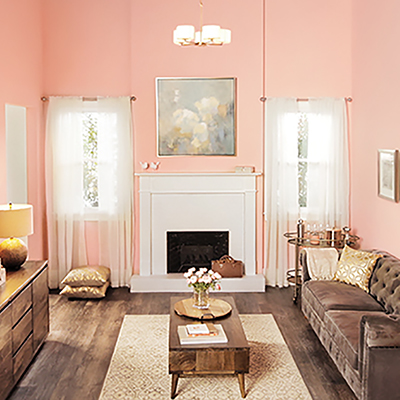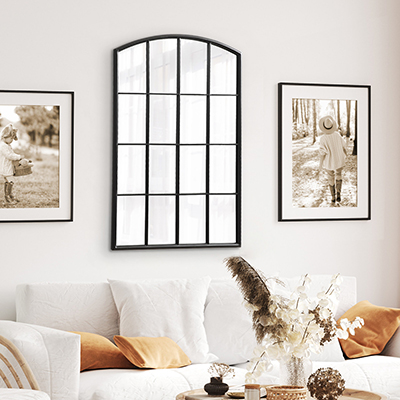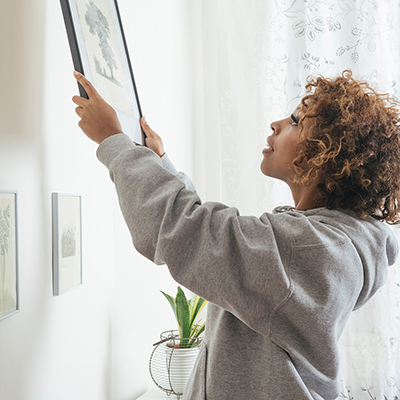How to Hang a Heavy Mirror

Last updated June 26, 2024
Decorative mirrors are a great way to brighten a room. They make even the tiniest space feel larger and more inviting. Plus, in an entryway, mirrors give you final checkpoint before walking out the door. A multi-purpose piece of art, decorative mirrors can be heavy. It’s important to know how to hang a mirror properly. Read on for several step-by-step mirror installation options. Avoid the common pitfalls of hanging a heavy mirror.
Difficulty:
Beginner
Duration:
Under 2 hours
Table of Contents
Evaluate the Wall
Use the Right Hardware
Decide the Best Hanging Method
How to Hang a Mirror with D-Rings
Measure Wall
Measure D-Ring Spacing
Evaluate the Wall

Knowing how to hang a mirror on a wall starts with figuring out the type of walls you have. First, determine what your wall is made of. The easiest option is to press a push pin into the wall. If the point slides in easily, you’re working with drywall. If not, it’s likely plaster. If you have a wall made from brick, concrete or stone, you’ll need specialty hooks and hangers.
Since you’re working with a heavy piece, using the proper hardware for the weight and wall type is essential. The weight of the mirror you plan to hang determines the proper anchors and mounting hardware for mirror installation. Check the mirror’s packaging for weight specifications. Or simply set the mirror on a bathroom scale.
Securing your hanger into a stud is the strongest and safest way to install any heavy wall art. Once you’ve located a general area for the mirror, use an AC stud finder to identify nearby studs and readjust the hanging location if possible.
Use the Right Hardware

Make sure to check the back of your mirror to see what hanging hardware is already attached. If the hardware looks old or worn, consider exchanging it for something that is newer and safer. Depending on your wall, you may even want to exchange new hardware for something better.
If a stud is available for installation, your job will be streamlined. Use a hook that is rated for the mirror’s weight. Most new hardware will list weight maximums on its packaging. Be sure to use a sturdy anchor. If a stud doesn’t work into your plan, determine what type of anchor to use.
- Drywall Anchor. Generally plastic, these are the anchors often included with new frames, mirrors and other hanging products. They’re the obvious solution of how to hang a heavy mirror on drywall. While drywall anchors do the trick, their flexible housing can be hard to work with.
- Toggle Bolts. Also known as toggle anchors and toggle drywall anchors, these anchors have zinc-plated bolts that are sturdier than their plastic counterparts. They come with a companion screw.
- Heavy-Duty Self-Drilling Anchors. These anchors are screwed directly into the wall and don’t require a pilot hole. Their structure allows them to stay intact so they’re less likely to open as plastic anchors can.
Decide the Best Hanging Method

The type of hardware you use depends on whether you’re hanging your mirror with a wire, a D-ring or a French cleat. Choose what works best for you and your specific mirror. Different mirrors may require different hanging methods and measurement options.
Tip: It’s a good idea to ask a friend or partner to help with heavy mirrors.
How to Hang a Mirror with D-Rings

Many manufacturers include D-rings on the back of their frames. They are one of the most common ways of how to hang a mirror on a wall. D-rings offer some of the best security for heavy items. Once the D-rings have connected with their wall hooks, your heavy mirror will sit snug to the wall.
It's important to make sure the rings are equally distant from the top edge. Measure down from the top edge of the frame to each D-ring to see if the distances match. Match your wall marks to reflect any varying dimensions. Remember, these marks will not be level if the D-rings are not an equal distance from the frame’s top edge.
Measure Wall

After determining where you want to hang your mirror, mark the center point with a pencil.
- Measure up 57 inches from the floor. Add half the height of the mirror. This will determine the top edge of the mirror. Mark with a pencil.
- When the placement of the D-rings on your mirror are identical, measure the distance from the top edge of the frame down to the highest point of the D-ring on one side. Use this number to measure down from the center line. Mark with a pencil or painter’s tape.
Measure D-Ring Spacing

To determine the distance between the D-rings, create a pattern using your level. With the mirror face down on a flat surface, set your level against the top of each ring. Mark the distance directly onto the level or use painter’s tape.
Draw Level Line

- Place your level on the wall, aligning the center point.
- Transfer the marks from the level to the wall for the final position of the screws.
- If you are not securing hardware into studs, drill pilot holes.
- Install anchors that are appropriate for your wall type and the weight of the frame.
- Install the screws into the anchors or hangers into the wall.
Install the Mirror

Hang the mirror and level it. Make sure to ask someone to help you. The weight of the mirror can make it difficult to properly align D-rings and their hooks alone.
How to Hang a Frameless Mirror

Frameless mirrors are most often found in bathrooms. If no hardware is attached to the back of the mirror:
- Apply construction adhesive to both the wall and the back of the mirror.
- Lift and set the mirror in place with the help of a friend.
- Use a clean foam paint roller to evenly apply pressure across the mirror.
- Press the mirror to the wall.
- Let the glue set by taping the corners of the mirror to the wall with masking tape.
- Make sure to follow manufacturer instructions about maximum wieght and drying time.
Tip: Some frameless mirrors come with D-rings attached to the back with a strong adhesive. If so, use the instructions above for mounting with D-rings.
Mirror Installation Using Wire

When it comes to knowing how to hang a mirror on a wall, picture wire is a popular option. If you plan to use wire with a heavy mirror or other wall art, be sure you choose the right gauge. The gauge will be listed on the package and must be strong enough to handle the weight. If there are D-rings on the back of the mirror, make sure to twist the wire securely through them.
To hang a heavy mirror with wire, plan to set two hangers into the wall to distribute the weight.
- After determining the mirror’s placement, mark the center point with a pencil.
- Measure up 57 inches from the floor and then add half the height of the mirror. Mark the measurement. This is the top edge of the mirror.
- Have a friend hold the mirror up by the wire, distributing the weight.
- Measure the distance from the top edge of the frame to the wire. Also measure the distance between the holder's two hands.
- Transfer the measurements to the wall by measuring down from the top-edge reference mark. For example: If the wire is taut 8 inches down from the top of the frame and the distance between the hands is 12 inches, mark 8 inches down from the top center mark. Then mark 6 inches out to the left and the right.
- Level the two hand marks and place an “X” at each to mark the screw placement.
- If you are not securing hardware into studs, drill pilot holes. Install anchors that are appropriate for your wall type and the weight of the frame.
- Install the screws into the anchors or hangers into the wall.
- Hang the mirror and make sure it is level.
Tip: Be aware that wire can stretch over time, so plan on checking the integrity periodically.
How to Hang a Mirror with a French Cleat

The French Cleat is another great solution for hanging very large or heavy wall pieces. This two-piece combination comes in a variety of sizes capable of handling frames that weigh anywhere from 50 to 400 pounds.
Use the correct cleat for your mirror’s weight and install the top plate to the back of your frame. Use the included screws and follow the manufacturer instructions.
- Be sure the cleat is centered and level. The lip of the cleat will face down, toward the bottom of the frame.
- Determine where you want to hang your mirror. Mark the center point with a pencil.
- Measure from the top of the mirror frame to the bottom of the attached cleat. Using this measurement, measure down from the center point on the wall and mark.
- Use a level and draw a horizontal guideline about 6 inches along this point.
- Align the top edge of the wall cleat with the line. The lip of the cleat should face the ceiling.
- Mark and drill the pilot holes. Where studs aren’t available, install anchors.
- Hold the cleat in place and screw it in securely.
- Slide the mirror frame down the wall until the cleats lock together.
Mirrors are a stylish and dramatic way to add impact to a wall or a whole room. Mirrors, however, can be very heavy. Hanging a heavy mirror successfully is a DIY project you can do yourself with the right tools, patience and a helper. When you’re hanging a heavy mirror, or any hefty wall art piece, there are several safe and secure methods to choose from. Ready to get to work? The Home Depot delivers online orders when and where you need them.



























